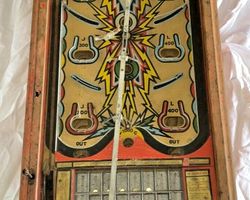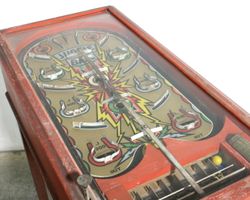Juggle Ball

Average Prices: USD $500 to $900
Produced: September, 1932
Machine Type: Pure Mechanical
Players: 1
"Juggle Ball" by Rock-ola Manufacturing Corporation stands as a distinctive artifact from the nascent days of coin-operated games, a testament to early innovation in the burgeoning pinball industry. Released in September 1932, this pure mechanical table-top machine emerged from the workshop of David C. Rockola, a figure instrumental in shaping the company's early identity. The design ethos of "Juggle Ball" pivoted on a groundbreaking concept for its era: direct player control over the ball's movement during play. This deviation from the prevalent passive-play machines of the time set it apart.
The design and production process for "Juggle Ball" were led by David Rockola himself, who is credited with the core mechanical design. This inventiveness is evidenced by multiple patents filed around the machine's release, including DE 87,759 and 1,942,880, both granted to David C. Rockola, alongside patent 1,942,898 granted to William L. Nelson, all filed in July 1932. These patents underscore the technical sophistication embedded in this early design. "Juggle Ball" was produced in a relatively limited run of approximately 1,000 units. Its compact form factor, measuring 34 inches long, 17 inches wide, and tapering from 9.5 inches high at the back to 7 inches at the front, made it suitable as a counter-top game. The addition of a control flipper handle and penny coin mechanism extended its effective length to about 37 inches. Operators could also acquire optional matching wood or steel stands, transforming it from a counter game into a standalone piece. The introduction of "Juggle Ball" coincided with other early player-controlled games like Hercules Novelty's "Double-Shuffle (Junior)" and Bingo Novelty Manufacturing Company's "Scoop," positioning it within a small but significant group that began to redefine player interaction in the field.
Signature Features and Design
The defining characteristic of "Juggle Ball" is its pioneering approach to player interaction, centered around a movable rod designed to influence the ball once it is in play. This mechanism allowed for a level of direct ball manipulation previously unseen, moving beyond simple plunger launches and static targets. The game allowed for either 1-cent or 5-cent play, a common feature for arcades of the period. The ball shooter alley is situated on the left side of the playfield, a design choice that dictated the initial trajectory of the solid white marbles used for gameplay.
Beyond its mechanical ingenuity, the machine features a distinct visual aesthetic. The artwork, described by some as "WILD art," utilizes bold colors and abstract forms, which some interpret as reflecting influences from contemporary art movements. This artistic choice elevates the machine beyond a mere mechanical device, giving it a unique visual identity that commands attention. The slingshot launching mechanism, though simple by later standards, provided a satisfying tactile response for players, enhancing the overall engagement. These combined elements—the innovative control, the robust mechanical design, and the distinctive artwork—coalesce to create a cohesive and engaging experience for its time.
Playfield and Mechanics
The playfield of "Jugble Ball" is a lesson in economical yet effective design, specifically crafted around the central mechanic of player-controlled ball manipulation. The manual plunger on the left initiates the action, sending a solid white marble up the shooter alley. The core of the playfield is dominated by various scoring pockets and targets arranged to allow for strategic interaction with the movable rod. The primary objective involves spelling "J-U-L-E" by guiding the ball into specific targets, a task designed to be achievable and encouraging. However, the true challenge and skill test come from attempting to score the two "G" targets, which are positioned to be extremely difficult to hit, demanding exceptional precision and timing with the movable rod.
The flow of "Juggle Ball" is dictated by this interactive rod. Players are encouraged to keep the ball in play for as long as possible, using the rod to direct it away from outlanes and towards desired scoring zones. This design philosophy aimed to shift the game from pure chance to one emphasizing player skill and dexterity. The absence of an electronic display means all scoring is purely mechanical, indicated by the ball landing in specific pockets or activating physical mechanisms. The artwork directly applied to the playfield provides visual cues for scoring areas and adds to the game's overall charm, creating a cohesive aesthetic that feels both playful and functional for its pre-war vintage. The visual simplicity combined with the mechanical depth defines the machine’s immersive qualities.
Gameplay Dynamics
"Juggle Ball" introduces a gameplay dynamic that was revolutionary for 1932: direct, persistent player influence over the ball. Unlike earlier machines where the ball's trajectory was largely determined by the initial plunge and then left to gravity and static obstacles, "Juggle Ball" empowers the player with a movable rod. This allows for continuous manipulation, offering the potential to keep a ball in play for an extended duration. This player-driven longevity was a significant departure, directly rewarding skill over luck.
The game's progression is straightforward but engaging. The immediate objective for new players is to spell "J-U-L-E," which is designed to be relatively easy and provides an encouraging sense of achievement. The true test, however, lies in achieving the "G" scores. Hitting these two particular targets is notoriously difficult, requiring a masterly command of the movable rod and precise timing. This high skill ceiling motivates repeated play, as players strive to refine their technique and conquer the elusive "G" targets. The scoring system is simple but effective: landing in specific holes or activating targets registers points. A critical element of its challenge is the unforgiving nature of its "lives" system; players are afforded only two "spare" balls, meaning the game ends quickly if skill falters. This scarcity of allowances amplifies the pressure and reward of mastering the ball manipulation, making every shot count and contributing to the machine's memorable, yet demanding, gameplay experience.
Reception and Legacy
"Juggle Ball" holds a unique and esteemed position within the pinball community, primarily due to its pioneering player-controlled ball manipulation and its scarcity. Its limited production run of approximately 1,000 units contributes significantly to its high collectibility today. Feedback from those who have encountered the machine consistently highlights its inventive nature for its time. Strengths frequently cited include its "brilliant" design and being "amazing for its age," particularly in its ability to provide extended, skill-based gameplay. Players often describe it as "fun" and "timeless," finding joy in the challenge of keeping the ball in play for an extended duration, a direct result of the movable rod mechanism. The "WILD art" is also frequently praised for its distinct visual appeal, adding to its overall charm. Its unusual and satisfying slingshot launching mechanism further contributes to its unique feel.
However, the machine is not without its acknowledged difficulties. The extreme challenge of scoring the two "G" targets is a common point of discussion, often described as requiring "great skill" and being a source of considerable frustration. The limitation of only two "spare" balls means the game is notably unforgiving, demanding near-flawless play to achieve high scores or extended sessions. While this challenge contributes to its allure for skilled players, it would have presented a financial challenge for operators in 1932, as the low number of units meant fewer opportunities for revenue generation.
Despite these challenges, "Juggle Ball"'s legacy is overwhelmingly positive. It is considered a "top all-time collectible" due to its rarity and historical significance. Its innovative ball manipulation concept proved that pinball could be more than a game of chance, laying conceptual groundwork for future interactive features that would evolve over decades. "Juggle Ball" demonstrated the potential for player dexterity and strategy to be central to the experience, an idea that profoundly influenced the direction of pinball as it matured. Its continued presence in private collections and its display in locations dedicated to preserving historical arcade games underscore its enduring reputation as a pivotal early design in the development of mechanical gaming.
Sponsored Links
 Ebay Listings
Ebay Listings
 Auction Results
Auction Results
| Cost | Location | Date |
|---|---|---|
| USD $660 |  Michigan, United States Michigan, United States |
12 June, 2024 |
| USD $850 |  Maryland, United States Maryland, United States |
23 February, 2023 |
| EUR €370 |  Germany Germany |
21 March, 2020 |
| USD $100 |  New York, United States New York, United States |
22 June, 2011 |


Private Policy · Search Website · Contact Us
As an eBay Partner, we may earn a commission from qualifying purchases made through links on this site, at no additional cost to you.
All trademarks and copyrighted materials remain property of their respective owners. All other content copyright 2007 - 2025 Pinpedia.


